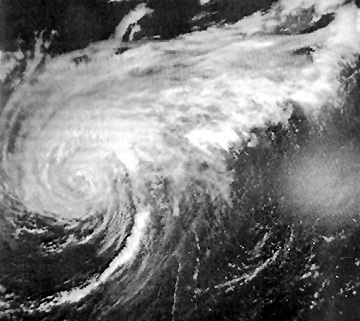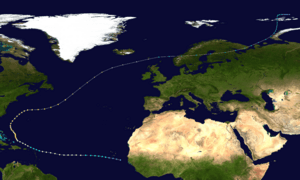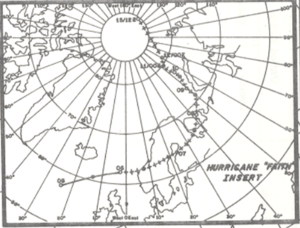Hurricane Faith facts for kids
| Category 3 major hurricane (SSHWS/NWS) | |

Hurricane Faith on September 1 as it moved towards Cape Hatteras
|
|
| Formed | August 21, 1966 |
|---|---|
| Dissipated | September 15, 1966 |
| (Extratropical after September 4) | |
| Highest winds | 1-minute sustained: 120 mph (195 km/h) |
| Lowest pressure | 950 mbar (hPa); 28.05 inHg |
| Fatalities | 4 direct, 1 indirect |
| Areas affected | Lesser Antilles, Bermuda, Faroe Islands, Iceland, United Kingdom, Ireland, Denmark, Norway, Sweden, Finland, Soviet Union, Arctic |
| Part of the 1966 Atlantic hurricane season | |
Hurricane Faith was a powerful and long-lasting storm that traveled across the Atlantic Ocean in 1966. It was the sixth named storm and fifth hurricane of the 1966 Atlantic hurricane season. Faith started as a tropical depression near Cape Verde on August 21. It slowly grew stronger as it moved west.
By August 23, it became a hurricane. Faith reached its first peak with winds of 105 mph (165 km/h). As it passed near the Lesser Antilles, its outer parts brought strong winds to places like Puerto Rico and the Virgin Islands. Some minor damage happened as far south as Trinidad and Tobago.
Faith became even stronger by August 28, reaching Category 3 hurricane status with winds of 120 mph (200 km/h). It then weakened slightly and turned northeast. One person sadly drowned in the Atlantic when their ship sank. The storm also brought heavy rain and strong winds to Bermuda, but luckily, no damage occurred there. Faith kept its strength as a Category 2 hurricane for several days as it moved into the far North Atlantic. It finally weakened near the Faroe Islands on September 6. Three more people drowned in the North Sea near Denmark, and another person died from injuries related to the storm.
How Faith Formed and Traveled
Hurricane Faith began as a stormy area over the Côte d'Ivoire (Ivory Coast) in Africa on August 18. This weather system slowly moved west and reached the Atlantic Ocean. On August 21, it officially became a tropical depression about 240 miles (385 km) southeast of Cape Verde.
The depression continued to move west and got stronger. On August 22, it was named Tropical Storm Faith. It kept getting stronger as it traveled west at about 17 to 23 mph (27 to 37 km/h). By August 23, Faith became a Category 1 hurricane. It then curved slightly northwest and briefly reached Category 2 strength with winds of 105 mph (165 km/h).
Faith weakened back to a Category 1 hurricane as it got closer to the northeastern Leeward Islands on August 25. It passed by these islands without much change in strength. But on August 28, near the Turks and Caicos Islands, Faith became a Category 2 hurricane again. Just six hours later, it quickly grew into a Category 3 hurricane.
On August 29, Faith reached its strongest point with winds of 125 mph (205 km/h). After this peak, Faith slowly started to weaken. By August 30, it was back to a Category 2 hurricane. At this time, it turned northeast, moving between Bermuda and Florida. Faith stayed far away from the East Coast of the United States and Atlantic Canada.
On September 1, it turned eastward and began to speed up. As it got closer to Europe, Faith was moving as fast as 50 mph (75 km/h). On September 3, the lowest air pressure related to the storm was recorded at 950 mbar (28.05 inHg). Faith had been a Category 2 hurricane since August 29, but it weakened to a Category 1 hurricane on September 6 as it neared the Faroe Islands.
Later that day, Faith changed into an extratropical storm (meaning it lost its tropical hurricane features) over the North Sea. It was about 125 miles (200 km) east-northeast of Tórshavn. The remains of Faith then moved east and brought strong winds of up to 60 mph (95 km/h) to Norway. It continued over Scandinavia, weakening to the strength of a tropical depression before entering the Soviet Union (now Russia). The storm eventually faded away over Franz Josef Land in the Arctic on September 15. This was about 600 miles (965 km) from the North Pole.
How Hurricane Faith Affected People and Places
When Hurricane Faith approached the Leeward Islands, a tracking station on Antigua had to shut down. This station was watching a rocket launched by NASA. Faith also caused strong winds across Puerto Rico and the Virgin Islands. However, only minor damage was reported, and no one was hurt or killed there.
Further south, Faith brought rough seas to Trinidad and Tobago. Waves were as high as 10 to 15 feet (3 to 4.5 m). These conditions caused small damage to boats and docks. In the Turks and Caicos Islands, some sea defenses were damaged as Faith passed about 65 miles (105 km) to the east-northeast. Along the East Coast of the United States, the storm caused rough seas and high tides from Cape Canaveral, Florida, to the Virginia Capes. Weather officials warned of possible strong winds in The Carolinas and Virginia, but these areas only felt minor effects from the storm. In Bermuda, the outer rain bands of Hurricane Faith brought heavy rain and wind gusts up to 62 mph (100 km/h).
Sadly, five people died because of the storm. Only one of these deaths happened on land. In the western Atlantic, rough seas caused one man to fall overboard from the ship Alberto Benati. Two other people drowned near Denmark while trying to cross the Atlantic in a rowboat. Another man went missing and was believed to have died after heavy seas forced him and his shipmates to leave their boat off the northern coast of Denmark.
The total property damage from Faith was small. This was mainly because the areas hit hardest by the storm were not very populated. A large Norwegian car ferry called Skagerak started to sink while heading for Hirtshals in Denmark. Waves crashed into the side hatches, flooding the engine room and making the ship unable to move. A big rescue operation saved all 144 passengers on board. They were treated for injuries in Hjørring, Denmark. However, one person later died in the hospital.
In Norway, the remains of Faith brought heavy rainfall to areas between Ryfylke and Sunnfjord. This rain caused glaciers to melt, which led to widespread flooding in some places. The water flowing from the Folgefonna, Fjærland, and Sunnfjord glaciers reached record high levels because of the rain from Faith.
See also
 In Spanish: Huracán Faith para niños
In Spanish: Huracán Faith para niños




